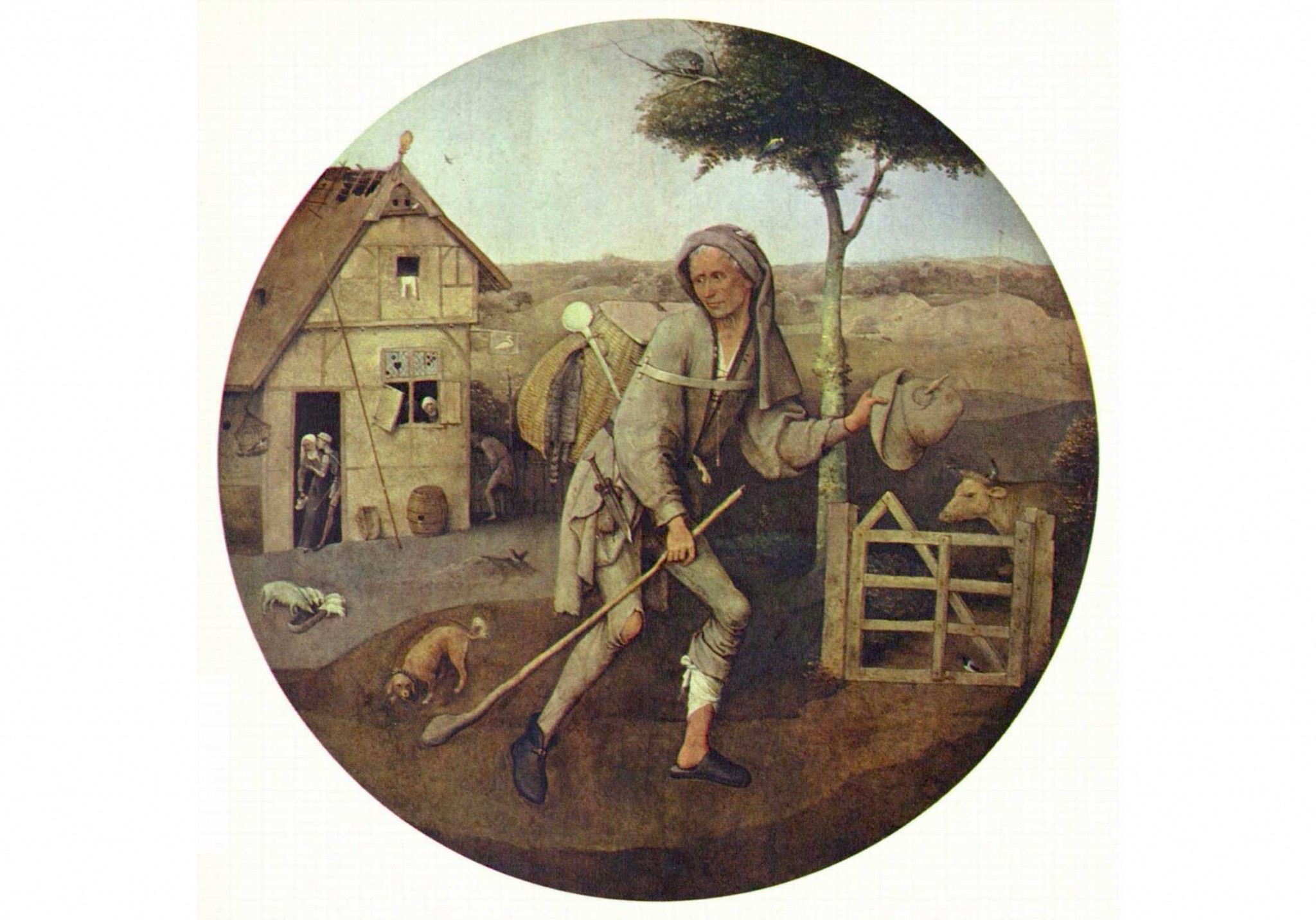
Daniëls 1989
De Verloren Zoon tussen hel en hemel. De tondo van Jeroen Bosch in Museum Boymans van Beuningen te Rotterdam opnieuw beoordeeld (G.L.M. Daniëls) 1989
[Unpublished master thesis, Universiteit Utrecht, 14th July 1989, 61 pages + 31 illustrations]
By using a ‘historically and anthropologically oriented’ iconographical approach Daniëls tries to demonstrate that The Prodigal Son is the correct title of the Rotterdam Pedlar tondo. The bottom line of his interpretation is that the identification of the tramp as the Prodigal Son can be derived from the symbolism of the landscape he is passing through. The protagonist of the tondo is walking on a road that leads to a gate and does not follow the (dead end) path leading towards a brothel. Daniëls interprets this brothel as a ‘Nobis pub’: a pub on the way to eternity where you can have a last drink. The brothel is said to be an image of hell, whereas the gate symbolizes heaven. This explains the title of this study: ‘The Prodigal Son between hell and heaven’. According to the author Bosch represented his ‘Prodigal Son’ as an allegory of sinful man who voluntarily chooses for a return to his father’s house. In doing so Bosch is said to have placed the parable in the humanist atmosphere of his times.
Daniëls’ text offers some correct insights (the landscape has a positive and a negative side, the owl has an unfavourable meaning, the hat has a special meaning because it is not just being held in the hand but clearly ‘shown’…), but the arguments are sometimes superficial, and at other moments arbitrary or even wrong. Superficial, arbitrary and wrong at the same time are for example the four lines about the thread on the ‘tramp’s’ hat: ‘A lot can be said in favour of seeing Ariadne’s thread of life in the curled-up thread, the (silk) thread on which life is pending and that can be lost through folly. Albertus Magnus used a thread to climb into heaven!’ ‘Ariadne’s thread of life’ is probably the result of an error, and the reference to Albertus Magnus is not really clear in this context. On the other hand no word is spent on the awl that fixes the thread to its place. Statements like these can be found a lot of times in Daniëls’ text and often they are written in a categorical style, for example ‘the rooster on the dunghill refers to lust’ [p. 23, without further comment or footnotes].
Daniëls’ pivotal argument to interpret the tramp as the Prodigal Son is that an inn and a gate also occur in other sixteenth-century Prodigal Son depictions, within the context of the ‘choice between the path of Good and the path of Evil’ motif. His references include a drawing attributed to Peter Coecke van Aalst (Daniëls’ illustration nr. 12) that depicts scenes from the life of the Prodigal Son. In this drawing we see, from left ro right, the Prodigal Son leaving his father’s house, the Prodigal Son and the whores and the Prodigal Son expelled from the brothel. According to Daniëls the ashamed Prodigal Son is herding swine under a tree in the right half of the drawing. He is sitting at a crossroads ‘that to the left allows access to the land of the forgiving father and to the right leads along the father’s house, into the (evil) world’ [p. 21].
On closer examination of the right half of the drawing it becomes clear, first, that there is no crossroads at all and, second, that the ‘right’ path does not lead along the father’s house, but towards it. So this path cannot lead into the ‘evil world’. Since the Prodigal Son under the tree is definitely herding swine, it is far more logical that the scene depicted to the left of the sorrowful Prodigal Son (and to the right of the expulsion from the brothel) represents the moment when the Prodigal Son is asking for shelter and work to the farmer who is standing behind his gate. In other words: Daniëls’ interpretation of this drawing (focusing on the opposition brothel-gate) is wrong and thus illustrates the superficial way in which he tries to support his argument (also elsewhere).
The weakest link in Daniëls’ text is the fact that he doesn’t relate the Rotterdam tondo to the closed wings of the Haywain triptych. This triptych is mentioned briefly, but here the tramp is interpreted as man leaving the sinful world behind him [p. 28]. An obvious question is then why the tramp in the tondo does represent the Prodigal Son, and the very similar figure in the closed wings of the Haywain doesn’t. Furthermore the author does not focus on the fact that the protagonist of the tondo is a pedlar and he doesn’t notice that the dog is a key symbol of the whole painting.
[explicit]